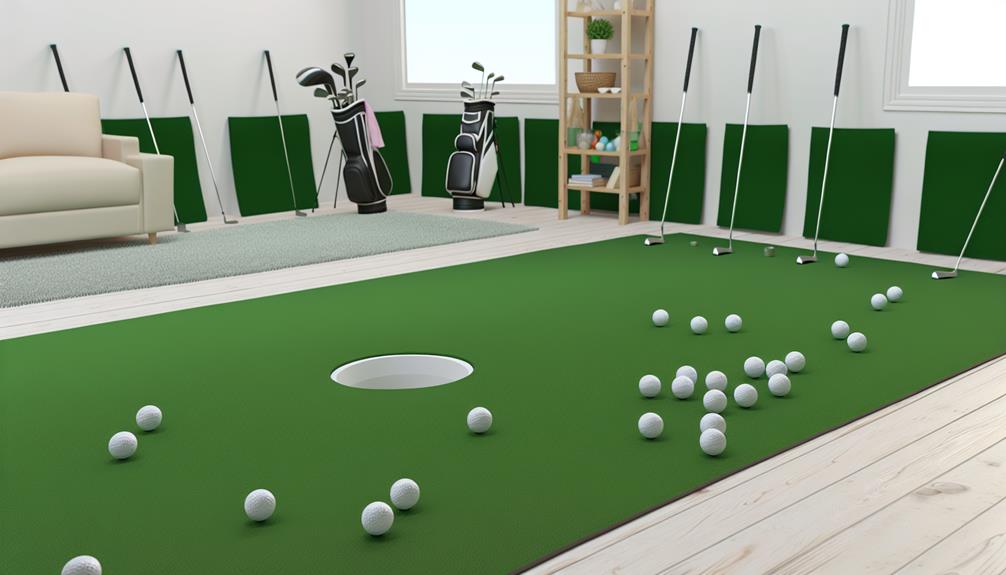Just as a chef needs the right set of knives to whip up a culinary masterpiece, you too need the right equipment to perfect your golf putting skills at home.
As you step into the world of golf, the vast array of training equipment might seem overwhelming. From numerous types of putting mats, golf balls, to various training aids, the choices are endless.
But don't worry, we're here to help you navigate through this sea of golf gear. We'll explore what to look for in quality home putting equipment, and how to choose the ones that are right for you.
So, are you ready to swing into action?
Understanding Golf Putting Basics
To master the art of golf putting, you'll first need to understand its core principles, such as stance, grip, and swing rhythm.
Let's start with grip techniques. If you're gripping the club too tightly, you'll limit your wrist action and control. Instead, try a light but firm grip, allowing your wrists to hinge naturally. Experiment with different grip styles, such as the reverse overlap, cross-handed, or claw, to find what works best for you.
Next, consider your stance adjustments. Your feet should be shoulder-width apart, with the ball positioned in the center. Your knees should be slightly bent and your weight evenly distributed between your feet. Your eyes should be directly over the ball for a clear view of the line to the hole.
Last but not least, your swing rhythm. It's crucial to maintain a steady pace in your backswing and follow-through. Imagine a pendulum swinging back and forth, smooth and unbroken. Practice keeping this rhythm consistent, regardless of putt length.
Essential Home Putting Equipment
Equipping your home with the right putting practice aids can significantly improve your golf game, and there are several key items you shouldn't overlook.
First and foremost, you'll need a quality putting mat. It's not just about the surface, but also the length and slope that can mimic the various conditions you'll encounter on the golf course.
Next, consider a putting mirror. This tool is crucial for correcting your putting posture. It allows you to see your alignment, eye position, and shoulder level, helping you achieve a consistent and correct posture every time. Remember, a good posture leads to better control and precision in your strokes.
Another vital tool is a putting gate. It helps you work on your stroke techniques by ensuring your ball starts on the intended line. It's an excellent aid for practicing breaking putts.
Lastly, a good-quality putter that suits your style and comfort is a must. It's an extension of your arm, so it needs to feel right.
These tools aren't luxuries, but essentials for a home golf putting practice. Invest in them, and you'll see the improvement in your putting game in no time.
Features of Quality Putting Mats
Building on the importance of having the right tools, let's take a closer look at the features that make a putting mat high-quality and effective for home practice.
The two standout features you should keep an eye out for are mat durability and surface realism.
Mat durability is a crucial aspect. You don't want your mat wearing out before you've improved your putting skills. Hence, look for a mat made of tough, long-lasting materials that can withstand repeated use without losing its form or functionality. Quality mats are often made with thick rubber backing for longevity and stability.
Surface realism, on the other hand, is about how well the mat replicates the true feel of a golf course green. A high-quality mat will mimic the smooth, firm texture of a real green, providing a consistent roll every time you putt. This feature helps you translate your practice into real-world performance.
Pay attention to details like stimp rating (a measure of the speed of the green) and whether the mat includes contours or slope variations. By selecting a durable mat with a realistic surface, you're setting yourself up for effective home golf putting practice.
Selecting the Right Golf Balls
Choosing the right golf balls for your home putting practice is as crucial as selecting a quality mat, and it's not a decision to be taken lightly. Ball durability is a key factor to consider. You'll need balls that can withstand repeated use without losing their shape or functionality. High-quality golf balls retain their form even after multiple rounds of intense practice, giving you consistent performance every time.
Consider the material of the golf balls. Urethane covered balls, for instance, provide exceptional feel and control, making them ideal for practicing putts. However, if you're just starting out or on a budget, surlyn covered balls might be a more cost-effective option.
Besides durability, personalized branding can be a fun and unique way to enhance your practice sessions. It's not just about having your name or initials on the balls. You can also use different colors or symbols to distinguish between different types of shots or drills. This way, you're not just practicing your putts, you're doing it in style.
Incorporating Training Aids in Practice
Incorporating training aids in your practice can significantly enhance your golf putting skills, enabling you to focus on specific areas for improvement. These aids can be particularly useful for working on your alignment, distance control, and consistency.
However, not all aids are created equal. This is where Aid Evaluation becomes crucial. It's essential to research and scrutinize each aid before integrating it into your practice. Look for aids that are proven to have a positive impact and are recommended by experts in the field.
Once you've selected a suitable aid, monitor your Training Progress consistently. This will help you determine the effectiveness of the aid and whether it's helping you reach your goals. You can do this by tracking your performance, noting any improvements, and identifying areas where further work is needed.

